|
|
MITTEILUNGEN DER
DEUTSCHEN GESELLSCHAFT FÜR NATUR-UND VÖLKERKUNDE OSTASIENS BAND XXII, Teil B. The descendants of the early settlers on the Bonin Islands. by Professor Dr. Richard Goldschmidt. TOKYO 1928 DEUTSCHE GESELLSCHAFT FÜR NATUR- UND VÖLKERKUNDE OSTASIENS 18 Hirakawacho 5-chome, Kojimachi-ku, Tokyo Available in bookstores from the publishing house "Asia Major" Leipzig, Fockestr. 55. |
|
The descendants of the ancient settlers on the
Bonin Islands. by Professor Dr. Richard Goldschmidt. The Bonin Islands, — the name is derived from mu nin to=no man's island — are located on the 27th parallel about 500 nautical miles due south of Yokohama, halfway between this port and the former German Mariana Islands. The few island marriages of volcanic origin are so small that they only appear as dots, if at all, on ordinary maps. They were discovered in the early 17th century by the Japanese daimyo Ogasawara, whose name they bear today as a Japanese possession. Despite their wonderful lush tropical nature and the gleaming harbor that the main island (today Chichijima) offers, they remained uninhabited; at least they were known, since the old fighter mentions them in his famous book on Japan. His tales of the lush beauty of the islands with their innumerable giant tortoises, deer, fish and good harbor made a great impression on some South Sea traders living in Honolulu and they decided to settle on the uninhabited islands. In June 1830 five men, namely the Genoese Matten Mazarro, the American Nathaniel Savory, the Englishman John Millinchamp, the Dane Charles Johnsen and the American Aldin Chapin arrived on the main island with a number of Kanaks from Hawaii and established a colony. Some of these later left the islands, others died without issue, leaving really only the Savory family, who prospered and were soon regarded as the head of the colony. Over the next few decades, a few more settlers arrived, some voluntarily, some left behind by the whalers. If we disregard |
the names that for some reason disappear again, these were above all an Englishman Webb, a "Portuguese" from Breva in the Cape Verdes, that is, a mulatto named Joachim Gonzales, an Englishman Robinson and a Negro from Bermuda , named George Washington. A German Allen from Bremen also appears later, but leaves no descendants. But there was never a white woman on the island; all the wives of the first settlers were Polynesians from Hawaii, Guam and Ponape. an Englishman Robinson and a Negro from Bermuda named George Washington. A German Allen from Bremen also appears later, but leaves no descendants. But there was never a white woman on the island; all of the early settlers' wives were Polynesians from Hawaii, Guam, and Ponape. an Englishman Robinson and a Negro from Bermuda named George Washington. A German Allen from Bremen also appears later, but leaves no descendants. But there was never a white woman on the island; all of the early settlers' wives were Polynesians from Hawaii, Guam, and Ponape. Let us pass over the details of the following story here; there is murder and manslaughter, robbery and the abduction of women by landing whalers, the political intrigues of Commodore Perry, but all in all the small remote colony was doing well. 1)It was not until the 1960s that the Japanese began to take an interest in the island again, initially only platonically. In 1875, however, they definitely declared their sovereignty over the island group, which was now called Ogasawara, and the settlement of which began immediately, without objection from England. Today 2000 Japanese live alone on the small Chichijima and struggle in their humble way with sugar cane cultivation, coral fishing, vegetable cultivation, cultivation of tropical fruits. The descendants of the old settlers were unmolested, but their good times are over. They still live by themselves in their old houses in a settlement a little away from the Japanese village on the big bay. They have their Anglican Church and the older and middle generation still speak English. Also they carry themselves, although all mixed races, with English racial pride and make a very good impression. But they cannot compete with the frugal Japanese, especially as they have little taste for low-yield, toilsome farming. There is not much other work either, and so they mostly live from fishing, which suits their independent adventurer blood best. But their days are numbered. The younger generation goes to Japanese schools, no longer speaks English and marries into Japanese families. The old generation — several of the children 1) For more details see Chalmondeley, A history of the Bonin Islands, London 1915. A travel book by the author "New Japan" (Berlin 1927 by Julius Springer) also contains a chapter on the Bonin Islands on pp. 207-234. |
of the first settlers are still alive—is dying out, and with them the tradition. In a generation at the latest, there will be no trace left of the old settlers in the Japanese population. Unless in occasional physical attributes; Under these circumstances, it was of course of the greatest interest to the heredity researcher to see before closing time some of this human crossing experiment, which, though not exactly simple, has the merit of being perfectly sound in the family records. After all, everyone knows the other and their family history inside out, and with the exception of the original progenitors, all generations are still alive. Of course, the ideal would be a precise anthropological record of the entire colony, which still numbers around 60 people. But the author lacked both the technical training and the time for this, plus the difficulties of photographing in the fortified zone. So it was only possible to try to establish exact pedigrees for the individuals that could be reached. During the main period of fishing, this was only about half of the colony, and such notes were then collected from them as are possible without anthropological investigation. But even these modest observations seem to me worthy of communication, since the probability is not great that the Japanese anthropologists, who have not yet properly studied their own so interesting people, will undertake the task of a systematic treatment. There are four families, variously related to each other, which form the core of the present settlers and of which I have been able to get to know a number of members, namely the Savory, Gonzales, Washington and Webb families, as well as some Robinsons. If we count the first settlers with their Polynesian women, the P generation, some F1 individuals from the Savory, Washington, Webb and Robinson are still alive, as well as F2 and F3, but only F2 and following from Gonzales. The following genealogical trees, which have been shared unanimously by several parties, especially the excellent priest Rev. José Gonzales, gives |
the family relationships. These family trees are not complete; they contain only those of the living which I have seen myself, and of the dead only those which are necessary for an understanding of the origin. 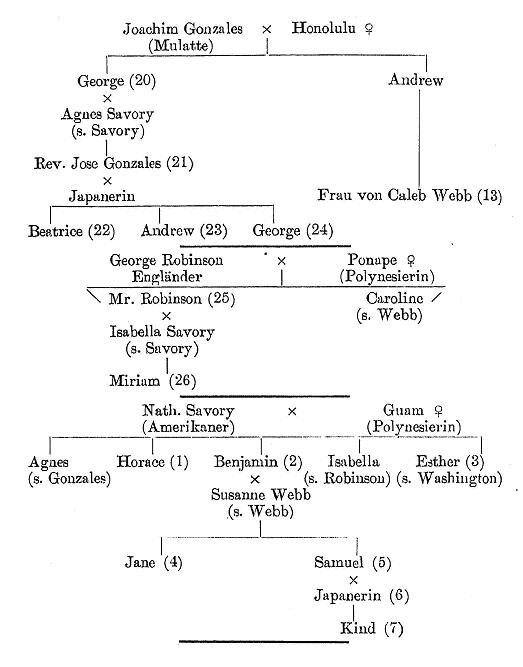 |
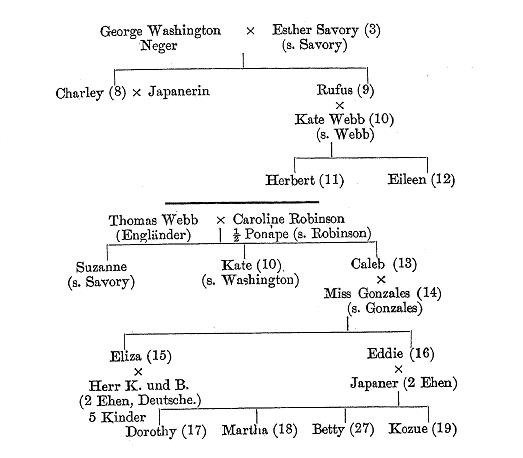 As these pedigrees, as aforesaid imperfect, show, there are all sorts of mixtures between Whites (mainly English-Americans, Savory came from Salem, Mass.), Negroes, Polynesians and Japanese. The following can be observed in these mixtures: From the original Fl individuals of the cross between White x Polynesian (Guam), 3 children of the old Nathaniel Savory are still alive, two men and one woman (pedigree Savory No. 1, 2, 3). They all show completely identical features. All three are tall, still vigorous people at over 70 years of age. The facial features are almost European with a slightly foreign touch in the nose and cheekbones, the skin color is hardly darker than you would expect from a white tropical dweller. The overall demeanor and demeanor is that |
of an American farmer. Arguably the strangest feature is hair and eyes. All of them were pitch black when they were young, but now that they are all three, they have not turned white, but blond with grey-blue eyes. The flaxen hair, of course, enhances the overall European impression, but contrasts oddly with the skin color. Certainly all three looked more mixed-race when they were young than they do now. Despite the flaxen hair, the old woman's face appears somewhat more mulatto-like than that of the men. These three individuals and the Robinson to be named later are the only pure F1 hybrids, all others are backcrosses resp. further generations. Most involve crosses of three breeds; A completely pure F2 generation does not exist, there is an almost pure one in the Robinson family. Another family comes very close, namely the family of Benjamin Savory. The father (No. 2) is correct F1 (Weiss x Guam), the mother Susanne Webb (no longer alive) is the product of a backcross between the Englishman Thomas Webb and the Englishman Robinson's daughter Caroline with a woman by Ponape. If we put W for White and P for Polynesians, the marriage of Benjamin Savory to Susanne Webb would be as follows: (P? x W?)? x [(P? x W?)? x W?]? so an approximation to F2. Unfortunately, only two of the children of this marriage were present, son Samuel (No. 5) and daughter Jane (No. 4). Coincidentally, these two already showed a complete split. Daughter Jane is pure white: white skin, auburn hair, and perfectly European features. On the one from the police photographer 1)poorly developed photography does not show this so clearly, even apart from the alien effect of the Japanese kimono. The only thing that might be striking about the girl is a quite unusual shade of brown hair, which is perhaps only due to the effect of the tropical sun. Another sister I didn't see is said to look similar but with a darker complexion. But the brother Samuel (5) is completely different. At best he has a strong crossbreed character, 1) Fortified zone, photography prohibited. |
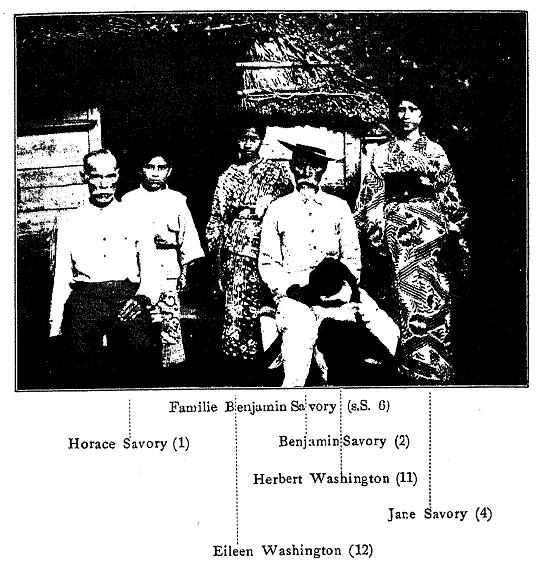 |
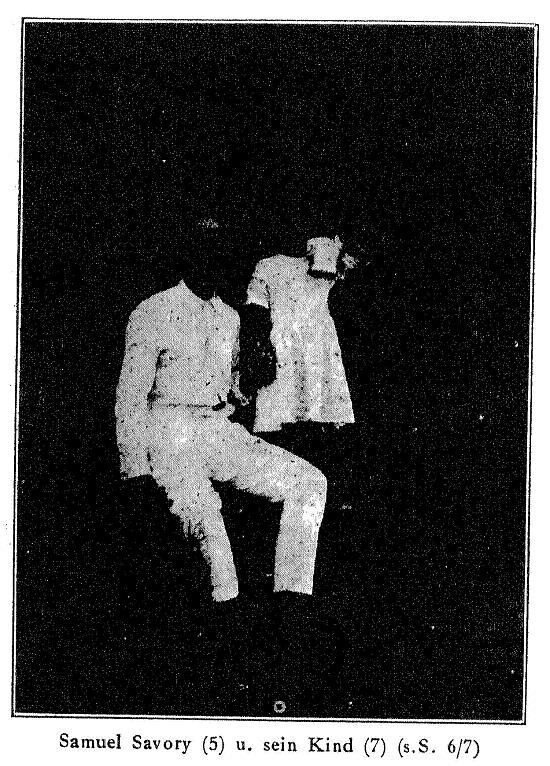 |
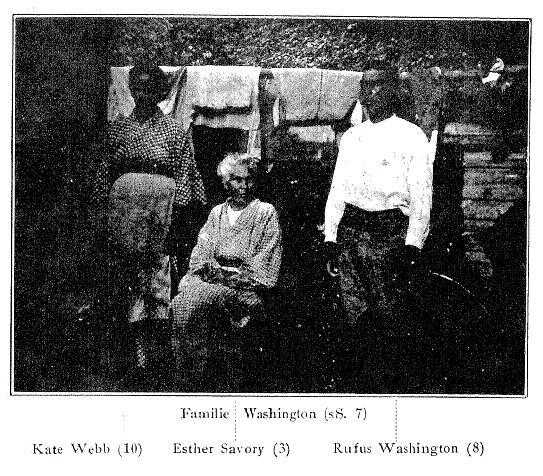 |
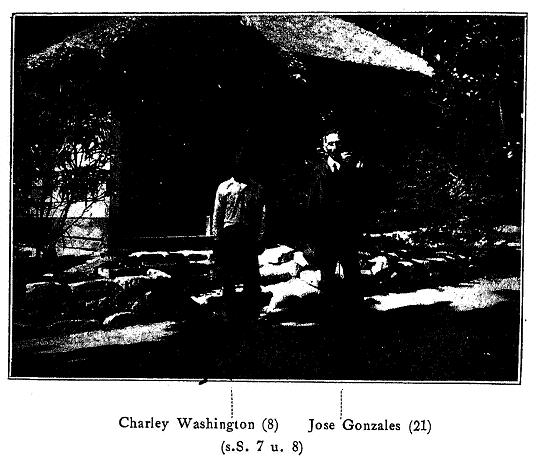 |
dark-skinned, and in the South Seas he would probably be mistaken for a not too dark Polynesian. Incidentally, this young man is married to a Japanese woman and has a child that no one could distinguish from a Japanese child. The Japanese traits are very dominant here, as well as in the crosses with pure Europeans. There is only one other crossbreed involving only two breeds, namely the older members of the Webb family. The two siblings Caleb (No. 13) and Kate (No. 10) descend from the backcross (P ? x W ?) ? x W ?. Of these, Caleb, though somewhat disfigured by drunkenness, appears entirely white. But his sister Kate has beautiful European facial features with a very good profile, black straight hair and very dark skin, so there is also a clear split here. The only almost pure F2 generation can be found in the Robinson family, but unfortunately only represented by one woman. Mr. Robinson (No. 25) is the fourth surviving F1 individual and his characteristics match those of the Savorys exactly. As his wife was a Savory we have an F2 cross here, apart from Robinson's dam being a Ponape female and Isabella Savory's being a Guam female. F2 daughter Miriam (No. 26) is much darker than her parents, almost black, but her features are more European than Polynesian. Very interesting are the crossings, in which Negroes are added to Whites and Polynesians, and finally even Japanese. First, there is the Washington family. The Bermuda Negro George Washington married Esther Savory (No. 3), so if we put N for Negro, the cross (P ? x W ?) ? x N ?. The two sons I saw, Charley (8) and Rufus (9) look like Negroes. Rufus in particular, whom the photograph shows next to his mother, comes across as a completely pure Negro. Charley, on the other hand, gives the impression of a mulatto with lighter skin and softer nose and lips, i.e. a split with a strong dominance of the Negro characters (woolly hair on both). Rufus is now married to Kate Webb (No. 10). So this marriage would be denoted as [(P ? x W ?) ? x W ?] ? x. [(P ? x W ?) x N ? ] ?. I got to see two |
of their children, Herbert (11) and Eileen (12), who are now splitting again. Herbert is a real little Negro boy with curly hair, dark skin, bulging lips. When taking pictures he hid himself, and only his. Frizzy head is slightly visible. Eileen shows a sympathetic mixture of the three races in her features. Straight, shiny black hair, dark skin, European cut nose and very little pursed lips. Even more complicated are the family trees and thus the possibility of divisions in the Gonzales family. The old Portuguese Gonzales was a mulatto. His son George with a wife from Honolulu looks in an old photograph a handsome mulatto of the sort known in the Far East as "Portuguese". He is said to have been very dark-skinned. His wife was a Savory, ie F1 P x W. Of the children I only know the son, the Rev. Jose Gonzales, 21. No doubt the Negro characters of three generations ago are clearly visible in him: very slight wavy hair, medium dark skin, strong lips and cheekbones, but European nose.He is now married to a Japanese woman and the crossbreed is now: [(P? x (W x N)?)? x (P? x W?)?]? x J?.From this marriage saw I have three children their diversity, however, leaves nothing to be desired. A girl Beatrice (22) is a perfect Japanese of the bright and beautiful Japanese type. Son George (24) looks strongly Japanese but with a touch of European features; but the son Andrew (23) is almost a Negro boy: curly hair, bulging lips, turned up nose, only the skin is a medium mulatto brown; another sister I haven't seen is said to be similar but a little less Negroid. only the skin is a medium mulatto brown; another sister I haven't seen is said to be similar but a little less Negroid. only the skin is a medium mulatto brown; another sister I haven't seen is said to be similar but a little less Negroid. The strong dominance that comes to light again here and perhaps also the extensive coupling of the Negro characters now also clearly emerges in the Webb family, into which the Negro blood of the Gonzales family came through Caleb Webb's wife. From this marriage (No. 13 x 14), which again includes Whites, Negroes and Polynesians, there are two daughters: one Eliza (No. 15) has practically European facial features, but slightly brown skin and very slightly wavy hair. Her sister Eddie (No. 16), however, has |
straight Negro hair and very dark skin, with facial features that are roughly European. This Eddie was married to Japanese in two marriages. I saw their four children. The daughter Dorothy (No. 17) again has semi-Negroid curly hair, dark complexion, but more Japanese features; Betty has quite a Japanese type, somewhat darkened doldrums and very slightly wavy hair, but also clearly some European touch; the other two girls Martha and Kozue (No. 18 and 19) appear Japanese at first, one with slightly darker skin. But Martha has a clearly negroid touch in her nose and mouth. Eliza (15) was married to German men in two marriages. Her children appear purely European to those familiar with Nick's family tree, but the hair of the elder daughters is still a tell-tale. As can be seen from the notes above, the case of the Bonin settlers offers nothing unexpected to the researcher of heredity, but rather expected phenomena of dominance and division. Perhaps one may add that physically and, above all, morally, these multiple half-breeds exist with honor. Despite all the mixtures, they kept up the good English tradition, which proved to be stronger than the blood mixture. Judging from the success in life that some emigrants from the islands have had, they are probably no different spiritually from other groups of people. |
|
Notes.
This is a 'Google Translate' product with only minor corrections. |
|
Source.
Richard Goldschmidt. This transcription was made from the monograph available at the website of Die Deutsche Gesellschaft für Natur- und Völkerkunde Ostasiens, Tokyo, auch Ostasiatische Gesellschaft (OAG).
Last updated by Tom Tyler, Denver, CO, USA, Nov 16 2022
|
|